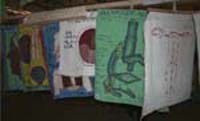10.2.1 Printed materials
Printed health learning materials can be used as a medium in their own right or as support for other kinds of media. Some printed health learning materials that you will already be familiar with include posters, leaflets and flip charts.
Posters

In recent years, the use of posters in communicating health messages has increased dramatically (Figure 10.7). Since a poster consists of pictures or symbols and words, it communicates health messages both to literate and illiterate people. It has high value to communicate messages to illiterate people because it can serve as a visual aid.
The main purposes of posters are to reinforce or remind people of a message received through other channels, and to give information and advice — for example to advise people to learn more about malaria. They also function to give directions and instructions for actions, such as a poster about practical malaria prevention methods. Posters can also serve to announce important events and programmes such as World Malaria Day.
Visual aids like posters explain, enhance, and emphasise key points of your health messages. They allow the audience to see your ideas in pictures and words. Box 10.3 gives some tips on preparing posters.
Box 10.3 Preparing a poster
- Written messages should be synchronised with pictures or symbols.
- All words in a poster should be in the local language or two languages.
- The words should be few and simple to understand. A slogan might contain a maximum of seven words.
- The symbols used should be understood by everyone, whatever their educational status.
- The colours and pictures should be ‘eye-catching’ and meaningful to local people.
- Put only one idea on a poster. If you have several ideas, use a flip chart (see below).
- The poster should encourage practice-action oriented messages.
- It is better to use real-life pictures if possible.
- It should attract attention from at least 10 metres away.
Flip chart
Flip charts are useful to present several steps or aspects that are relevant to a central topic, such as, demonstration of the proper use of mosquito nets or how HIV is transmitted. When you use the flip chart in health education you must discuss each page completely before you turn to the next and then make sure that everyone understands each message. At the end you can go back to the first charts to review the subject and help people remember the ideas.
Leaflets
Leaflets are the most common way of using print media in health education. They can be a useful reinforcement for individual and group sessions and serve as a reminder of the main points that you have made. They are also helpful for sensitive subjects such as sexual health education. When people are too shy to ask for advice they can pick up a leaflet and read it privately.
In terms of content, leaflets, booklets or pamphlets are best when they are brief, written in simple words and understandable language. A relevant address should be included at the back to indicate where people can get further information.
Think for a moment about how you have seen printed materials used for health education messages. Think about posters which have been successful and made an impact, about how other health educators have used flip charts. So you can always ‘copy’ the way that other people do things. If you have a talent yourself or know someone else who does, you can experiment with posters and flip charts (Figure 10.8).

10.2 Health learning materials
